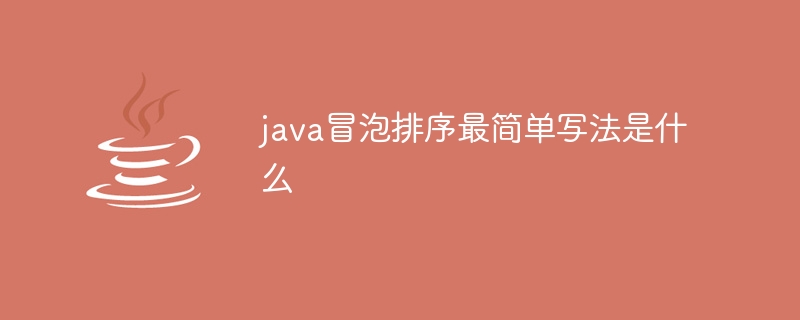What is the simplest way to write bubble sort in java
The simplest way to write Java bubble sort: 1. Use two nested for loops to compare adjacent elements and exchange them. The outer loop controls the number of rounds of comparison and exchange, and the inner loop uses By traversing the array and performing comparison and exchange operations, after each round of the inner loop, the largest element will be swapped to the end of the array; 2. Use the main method to create an array containing some integers, and call the bubbleSort method to sort the array Sort; 3. Print the sorted array, etc.

# Operating system for this tutorial: Windows 10 system, Dell G3 computer.
The simplest way to write Java bubble sort is as follows:
public class BubbleSort {
public static void bubbleSort(int[] arr) {
int n = arr.length;
boolean swapped;
for (int i = 0; i < n - 1; i++) {
swapped = false;
for (int j = 0; j < n - i - 1; j++) {
if (arr[j] > arr[j + 1]) {
// 交换相邻元素
int temp = arr[j];
arr[j] = arr[j + 1];
arr[j + 1] = temp;
swapped = true;
}
}
// 如果没有发生交换,则数组已经有序,可以提前结束循环
if (!swapped) {
break;
}
}
}
public static void main(String[] args) {
int[] arr = {64, 34, 25, 12, 22, 11, 90};
bubbleSort(arr);
System.out.println("排序后的数组:");
for (int i = 0; i < arr.length; i++) {
System.out.print(arr[i] + " ");
}
}
}In this simple bubble sort implementation, we use two nested for loops to compare adjacent elements and Make an exchange. The outer loop controls the number of rounds of comparison and exchange, and the inner loop is used to traverse the array and perform comparison and exchange operations. After each round of the inner loop, the largest element is swapped to the end of the array. The end condition of the inner loop is n - i - 1, where n is the length of the array and i is the index of the outer loop. The inner loop also uses a swapped flag to determine whether a swap has occurred. If no swap has occurred, it means that the array is in order and the loop can be ended early.
In the main method, we create an array containing some integers and call the bubbleSort method to sort the array. Finally, we print the sorted array.
The time complexity of this simple bubble sort implementation is O(n^2), where n is the length of the array. Although this implementation is simple and easy to understand, it is less efficient for large data sets. Therefore, in practical applications, other more efficient sorting algorithms may need to be considered.
The above is the detailed content of What is the simplest way to write bubble sort in java. For more information, please follow other related articles on the PHP Chinese website!

Hot AI Tools

Undresser.AI Undress
AI-powered app for creating realistic nude photos

AI Clothes Remover
Online AI tool for removing clothes from photos.

Undress AI Tool
Undress images for free

Clothoff.io
AI clothes remover

AI Hentai Generator
Generate AI Hentai for free.

Hot Article

Hot Tools

Notepad++7.3.1
Easy-to-use and free code editor

SublimeText3 Chinese version
Chinese version, very easy to use

Zend Studio 13.0.1
Powerful PHP integrated development environment

Dreamweaver CS6
Visual web development tools

SublimeText3 Mac version
God-level code editing software (SublimeText3)

Hot Topics
 Square Root in Java
Aug 30, 2024 pm 04:26 PM
Square Root in Java
Aug 30, 2024 pm 04:26 PM
Guide to Square Root in Java. Here we discuss how Square Root works in Java with example and its code implementation respectively.
 Perfect Number in Java
Aug 30, 2024 pm 04:28 PM
Perfect Number in Java
Aug 30, 2024 pm 04:28 PM
Guide to Perfect Number in Java. Here we discuss the Definition, How to check Perfect number in Java?, examples with code implementation.
 Random Number Generator in Java
Aug 30, 2024 pm 04:27 PM
Random Number Generator in Java
Aug 30, 2024 pm 04:27 PM
Guide to Random Number Generator in Java. Here we discuss Functions in Java with examples and two different Generators with ther examples.
 Armstrong Number in Java
Aug 30, 2024 pm 04:26 PM
Armstrong Number in Java
Aug 30, 2024 pm 04:26 PM
Guide to the Armstrong Number in Java. Here we discuss an introduction to Armstrong's number in java along with some of the code.
 Weka in Java
Aug 30, 2024 pm 04:28 PM
Weka in Java
Aug 30, 2024 pm 04:28 PM
Guide to Weka in Java. Here we discuss the Introduction, how to use weka java, the type of platform, and advantages with examples.
 Smith Number in Java
Aug 30, 2024 pm 04:28 PM
Smith Number in Java
Aug 30, 2024 pm 04:28 PM
Guide to Smith Number in Java. Here we discuss the Definition, How to check smith number in Java? example with code implementation.
 Java Spring Interview Questions
Aug 30, 2024 pm 04:29 PM
Java Spring Interview Questions
Aug 30, 2024 pm 04:29 PM
In this article, we have kept the most asked Java Spring Interview Questions with their detailed answers. So that you can crack the interview.
 Break or return from Java 8 stream forEach?
Feb 07, 2025 pm 12:09 PM
Break or return from Java 8 stream forEach?
Feb 07, 2025 pm 12:09 PM
Java 8 introduces the Stream API, providing a powerful and expressive way to process data collections. However, a common question when using Stream is: How to break or return from a forEach operation? Traditional loops allow for early interruption or return, but Stream's forEach method does not directly support this method. This article will explain the reasons and explore alternative methods for implementing premature termination in Stream processing systems. Further reading: Java Stream API improvements Understand Stream forEach The forEach method is a terminal operation that performs one operation on each element in the Stream. Its design intention is






